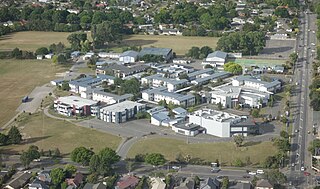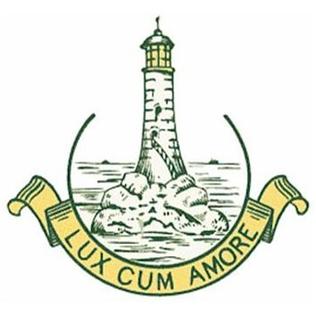Christ's College, Canterbury is an independent Anglican secondary day and boarding school for boys, located in the city centre of Christchurch, New Zealand.

Rangitoto College is a state coeducational secondary school, located on the North Shore of Auckland, New Zealand. Serving years 9 to 13, Rangitoto has a school roll of 3813 as of August 2024, making it the largest "brick-and-mortar" school in New Zealand. Patrick Gale is the current principal.

Cashmere High School is a state coeducational secondary school, located in southern Christchurch, New Zealand. It was opened in 1956 in response to population growth in southern Christchurch during the 1950s.

Burnside High School is a state co-educational secondary school located in the suburb of Burnside in Christchurch, New Zealand. With a roll of 2550 students, it is the largest school in New Zealand outside Auckland, and is among the country's four largest schools.

Rangi Ruru Girls' School is a New Zealand private girls' day and boarding secondary school located in Merivale, an inner suburb of Christchurch. The school is affiliated with the Presbyterian Church and serves approximately 703 girls from Years 7 to 13.

St Margaret's College is an independent girls' school in Christchurch, New Zealand founded on Anglican Christian values. It offers the dual academic pathway of NCEA and International Baccalaureate.

Christchurch Girls' High School in Christchurch, New Zealand, was established in 1877 and is the second oldest girls-only secondary school in the country, after Otago Girls' High School.

Middleton Grange School in Christchurch, New Zealand, is a state-integrated Christian co-educational Year 1 to 13 school. It's currently New Zealand's largest evangelical Christian school.

Wainuiomata High School, a state co-educational secondary school, operates in Wainuiomata, a suburb of Lower Hutt in New Zealand. The school was founded in January 2002 from the merger of Wainuiomata College and Parkway College. A total of 665 students from Years 9 to 13 attended the school as of August 2024.

John McGlashan College is a state integrated boarding and day school for boys, located in the suburb of Maori Hill in Dunedin, New Zealand. The school currently caters for 532 students from years 7 to 13, including 120 boarders and up to 30 international students.

John Paul College is a Catholic secondary school in Rotorua, New Zealand. The co-educational school enrolls students in years 7 to 13. It was opened in 1987 and combined two existing schools, Edmund Rice College and MacKillop College. The school was founded to serve the Catholic families of Rotorua. John Paul College is named for Pope John Paul II.

Waitaki Girls' High School is a state high school for girls situated in Oamaru, on the East coast of New Zealand. It was founded in 1887 on the initiative of local parliamentarians, Samuel Shrimski and Thomas William Hislop, and presently has a roll of just over 400 girls from the ages of 13 to 18. It also has a boarding hostel which houses approximately 50 girls, including international students and tutors.
St. John's College is a State Integrated, Catholic, Day School for boys, located in Hastings, a provincial city in Hawkes Bay, New Zealand.

Diocesan School for Girls (Dio) is a private girls' school in Epsom, Auckland, New Zealand. It is consistently a top-achieving school nationally. The school is Anglican-based and was established in 1903. It caters to international students and has accommodation for 50 boarders at Innes House. The school elected to offer students the option of International Baccalaureate diplomas, as an alternative to the national NCEA qualification, from 2008.

St Mary's College Wellington is situated in the suburb of Thorndon in Wellington, New Zealand. The school is a state-integrated all-girls Catholic secondary school for years 9–13.
In the New Zealand education system, decile was a key measure of socioeconomic status used to target funding and support schools. In academic contexts the full term "socioeconomic decile" or "socioeconomic decile band" was used.

Helen Connon was an educational pioneer from Christchurch, New Zealand. She was the first woman in the British Empire to receive a university degree with honours.

Rangiora High School is a state co-educational secondary school located in Rangiora, New Zealand. Established in 1881 by an act of parliament and opened in 1884, the school has a roll of 1640 students from years 9 to 13 as of August 2024, making it the fifth-biggest school in the South Island.
Helena Fannie Gibson was a New Zealand educator and the principal of Rangi Ruru Girls' School in Christchurch for its first 50 years.
Jessica Bygate is a former professional basketball player from New Zealand. She has played for the Melbourne Boomers in the WNBL and now lives is New South Wales. She is now a coach and an exercise scientist.
















